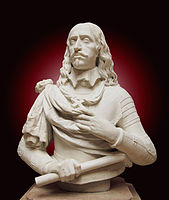Archduke
| Part of a series on |
| Imperial, royal, noble, gentry and chivalric ranks in Europe |
|---|
 |
|

Archduke (feminine: Archduchess; German: Erzherzog, feminine form: Erzherzogin) was the title borne from 1358 by the
The territory ruled by an archduke or archduchess was called an archduchy. All remaining archduchies ceased to exist in 1918. The current head of the House of Habsburg is Karl von Habsburg.
Terminology
The English word is first recorded in 1530, derived from Middle French archeduc, a 15th-century derivation from Medieval Latin archidux, from Latin archi- (Greek ἀρχι-) meaning "authority" or "primary" (see arch-) and dux "duke" (literally "leader").[2]
"Archduke" (
History
The Latin title archidux is first attested in reference to
The title was not used systematically until the 14th century, when the title "Archduke of Austria" was invented in the forged
The archducal title was only officially recognized in 1453 by
In 1477, Frederick III also granted the title of Archduke to his first cousin,
Archduke was initially borne by those dynasts who ruled a Habsburg territory—i.e., only by males and their consorts, appanages being commonly distributed to cadets. But these "junior" archdukes did not thereby become sovereign hereditary rulers, since all territories remained vested in the Austrian crown. Occasionally a territory might be combined with a separate gubernatorial mandate ruled by an archducal cadet.
Usage
From the 16th century onward, "Archduke" and its female form, "Archduchess", came to be used by all the members of the House of Habsburg (e.g. Queen Marie Antoinette of France was born Archduchess Maria Antonia of Austria). Upon extinction of the male line of the Habsburgs and the marriage of their heiress, the Holy Roman Empress-consort Maria Theresa, Queen of Hungary and Archduchess of Austria, to Francis Stephen, Duke of Lorraine, who was elected Holy Roman Emperor, their descendants formed the House of Habsburg-Lorraine. After the dissolution of the Holy Roman Empire this usage was retained in the Austrian Empire (1804–1867) and the Austro-Hungarian Empire (1867–1918).[5]
The official use of titles of nobility and of all other hereditary titles, including Archduke, has been illegal in the Republic of Austria for Austrian citizens since the Law on the Abolition of Nobility (Gesetz vom 3. April 1919 über die Aufhebung des Adels, der weltlichen Ritter- und Damenorden und gewisser Titel und Würden). Thus those members of the Habsburg family who are residents of the
For example, Otto Habsburg-Lothringen (1912–2011), the eldest son of the last Habsburg Emperor, was an Austrian, Hungarian and German citizen. As he lived in Germany, where it is permitted to use hereditary titles as part of the civil surname (including indications of origin, such as von or zu), his official civil name was Otto von Habsburg (literally: Otto of Habsburg), whereas in Austria he was registered as Otto Habsburg.[5]
The
-
The heir to the Austro-Hungarian throne,Archduke Franz Ferdinand(right) with his family. Ferdinand, along with his wife, was assassinated at Sarajevo in 1914, which sparked World War I
Insignia
The insignia of the Archduke of Lower and Upper Austria was the archducal hat, a coronet which is kept in Klosterneuburg Monastery.
See also
References and notes
- ^ Meyers Taschenlexikon Geschichte 1982, vol 1, p22 & vol 2 pp106 & 319
- ^ "archduke". Oxford English Dictionary (Online ed.). Oxford University Press. (Subscription or participating institution membership required.)
- ^ Schwenk, Peter. Brun von Köln (925–965). Sein Leben, sein Werk und seine Bedeutung (in German). Espelkamp: M. Leidorf. p. 41.
... man davon ausgehen muß, daß dieser Titel kein Amtstitel war. Dagegen sprit auch, daß außer Bruns Biograph Ruotger, Sigebert und Reiner keine andere Quelle den archidux-Titel erwähnt.
- ^ Grzęda, Mateusz (2016). "»Das älteste selbstständige Bildnis der deutschen Kunst«: A Reconsideration of the Portrait of Rudolf IV". In Fleckner, Uwe; Hensel, Titia (eds.). Hermeneutik des Gesichts. Das Bildnis im Blick aktueller Forschung. Berlin: De Gruyter. p. 132.
- ^ ISBN 3-7980-0700-4.
- ^ Konstantin Moritz A. Langmaier: Erzherzog Albrecht VI. von Österreich (1418–1463). Ein Fürst im Spannungsfeld von Dynastie, Regionen und Reich. Köln u. a. 2015, S. 644f.https://www.researchgate.net/project/Albrecht-VI-1418-1463


